
Mueller M.R. - Fundamentals of Quantum Chemistry[c] Molecular Spectroscopy and Modern Electronic Structure Computations (Kluwer, 2001)
.pdf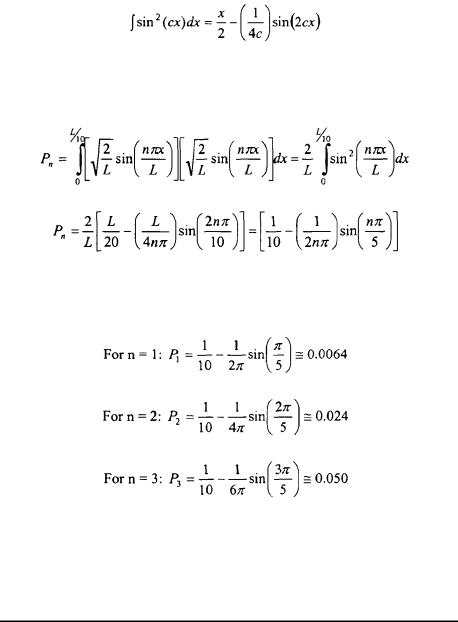
26 |
Chapter 2 |
The following integral will be used:
To find the probability in a region, the probability density must be integrated over that region of space.
The probability for each level in this region of the box can be computed by substitution of n.
The classical prediction is 0.1 for this region of the box for any energy of the particle. The quantum mechanical probability is much lower. The particle tends to “avoid” the walls where the potential is infinite. Also note that as the value of n approaches infinity, the classical result of 0.1 is obtained.
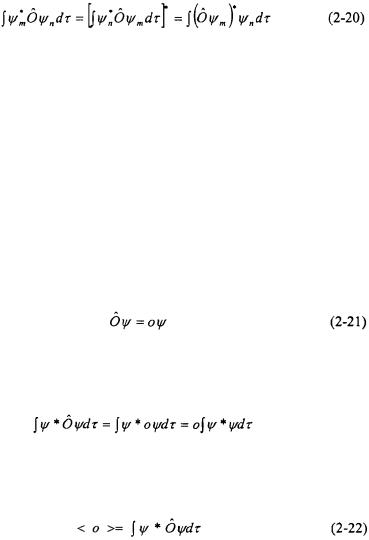
Fundamentals of Quantum Mechanics |
27 |
2.5 HERMITIAN OPERATORS
Hermitian operators are very important in quantum mechanics because their eigenvalues are real. As a result, hermitian operators are used to represent observables since an observation must result in a real number. Examples of hermitian operators include position, momentum, and kinetic and potential energy. An operator is hermitian if it satisfies the following relation:
for any two wavefunctions  and
and  The term on the right of Equation 2-20 means take the complex conjugate of the operator and the wavefunction then multiply by the wavefunction
The term on the right of Equation 2-20 means take the complex conjugate of the operator and the wavefunction then multiply by the wavefunction  and integrate overall space. This definition ensures that eigenvalues of hermitian operators (i.e. observables) are real.
and integrate overall space. This definition ensures that eigenvalues of hermitian operators (i.e. observables) are real.
2.6. OPERATORS AND EXPECTATION VALUES
As defined in Section 2.5, any hermitian operator,  signifies a mathematical operation to be done on a wavefunction,
signifies a mathematical operation to be done on a wavefunction,  which will yield a constant, o, if the wavefunction is an eigenfunction of the operator.
which will yield a constant, o, if the wavefunction is an eigenfunction of the operator.
Next the complex conjugate of the wavefunction,  is multiplied to both sides of Equation 2-21 and integrated over all space.
is multiplied to both sides of Equation 2-21 and integrated over all space.
If the wavefunction is normalized, then the integral  is equal to one as shown in Equation 2-9. This leads directly to the value of the constant o.
is equal to one as shown in Equation 2-9. This leads directly to the value of the constant o.
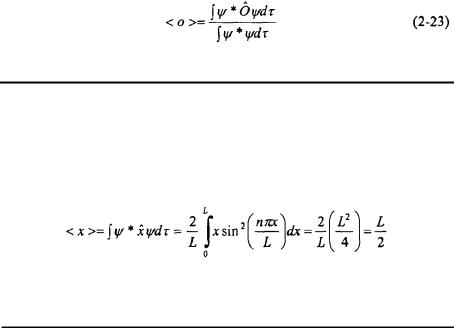
28 |
Chapter 2 |
As mentioned previously, the constant o corresponds to some physically observable quantity such as position, momentum, kinetic energy, or total energy of the system, and it is called the expectation value. Since the expression in Equation 2-22 is being integrated over all space, the value obtained for the physically observable quantity corresponds to the average value of that quantity. This leads to the fourth postulate of quantum mechanics.
Postulate 4: If the system is described by the wavefunction  the mean value of the observable o is equal to the expectation value of the corresponding hermitian operator, Ô.
the mean value of the observable o is equal to the expectation value of the corresponding hermitian operator, Ô.
Postulate 4 leads to the generalized expression below that can be reduced to Equation 2-22 if the wavefunction is normalized.
Example 2-2
Problem: Determine the average position, <x> for the Particle-in-a-Box model problem for any state n.
Solution: The integral, which must be solved, is that given in Equation 2-22.
This states that the average position of the particle is at the center of the box as is predicted by classical mechanics.
The types of integrals in Equation 2-23 are encountered often in quantum mechanics. Paul Dirac developed shorthand to represent these types of integrals called “bra-ket” notation. The integral in the numerator of Equation 2-23 is represented in “bra-ket” notation as follows:
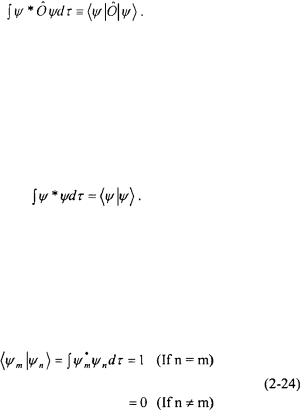
Fundamentals of Quantum Mechanics |
29 |
The “bra” of the wavefunction,  represents the complex conjugate of the wavefunction. The “ket” of the wavefunction,
represents the complex conjugate of the wavefunction. The “ket” of the wavefunction,  corresponds to the wavefunction which is operated on by the operator,
corresponds to the wavefunction which is operated on by the operator,  When the “bra” and “ket” are put together, it indicates that the product is to be integrated over all space. Equivalently, the integral in the denominator of Equation 2-23 is represented in “bra-ket” notation as follows:
When the “bra” and “ket” are put together, it indicates that the product is to be integrated over all space. Equivalently, the integral in the denominator of Equation 2-23 is represented in “bra-ket” notation as follows:
The value of this integral is unity if the wavefunctions are normalized and  and
and  correspond to the same state. If
correspond to the same state. If  and
and  correspond to different states, the value of the integral will be zero, and the wavefunctions are said to be orthogonal. Wavefunctions that are orthogonal and normalized are called orthonormal.
correspond to different states, the value of the integral will be zero, and the wavefunctions are said to be orthogonal. Wavefunctions that are orthogonal and normalized are called orthonormal.
2.7 THE HEISENBERG UNCERTAINTY PRINCIPLE
An interesting point to note in the Particle-in-a-Box model problem is that the ground-state energy is not zero as would be predicted by classical mechanics. The physical reason for this paradox has to do with uncertainties in knowing both the position and the momentum of the particle simultaneously due to the wavelike properties of the particle.
There is inherent error in any type of measurement. The standard deviation is an average range of measurements in a series of trials. As an example, suppose the following values were obtained for some measurement: 6.3, 6.8, 6.5, 6.2, and 6.9. The average value is 6.5. The individual trials deviate from this average by –0.2, 0.3, 0.0, -0.3, and 0.4. Simply taking an average of these deviations will result in some
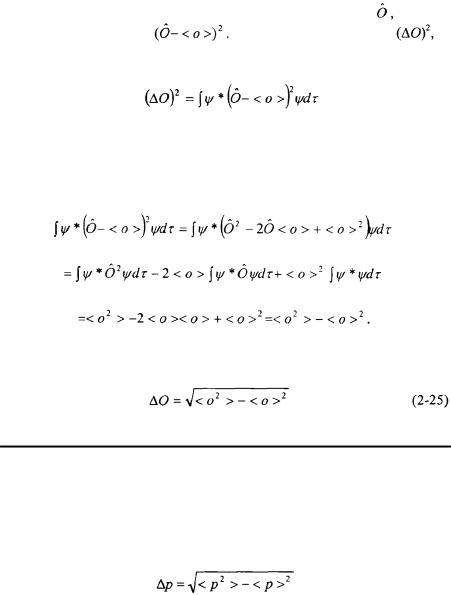
30 Chapter 2
cancellations since some of the deviations are positive whereas others are negative. To avoid these cancellations, a root mean square (rms) uncertainty is determined whereby the square root of the mean of the square of each deviation is obtained. For this set of measurements, the uncertainty is 0.3. Four of the five measurements are within the range of 
The analogous approach can be done in quantum mechanical systems.
The square of the difference of the operator for an observable, |
from the |
|
average, < o >, is taken: |
The uncertainty squared, |
is |
the expectation value of this operator. |
|
|
This expression can be simplified by expansion. The <o> corresponds to a constant which can factored out of the integration. Assume the wavefunction is normalized. Then
The uncertainty,  is the square root of the expression above.
is the square root of the expression above.
Example 2-3
Problem: Determine the uncertainty in the momentum,  for the groundstate energy of the Particle-in-a-Box model problem.
for the groundstate energy of the Particle-in-a-Box model problem.
Solution: According to Equation 2-25, the following must be solved.
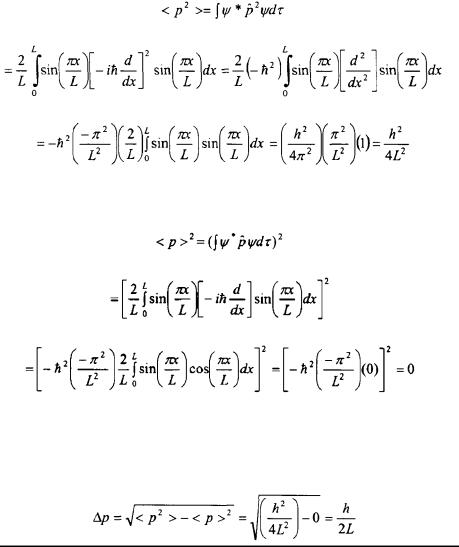
Fundamentals of Quantum Mechanics |
31 |
The expression above states that the average of the square of the momentum,  along with the square of the average momentum,
along with the square of the average momentum,  must be determined. The average of the square of the momentum is determined as follows.
must be determined. The average of the square of the momentum is determined as follows.
The average of the momentum squared is determined as follows.
Note that the average momentum is zero as would be expected: the particle must have an equal average momentum towards each side of the box. The standard root mean square deviation in the momentum can now be solved.
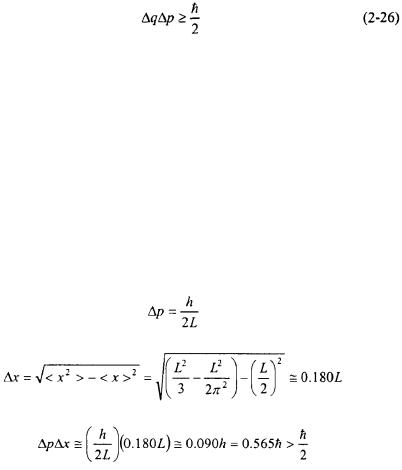
32 |
Chapter 2 |
The Heisenberg Uncertainty Principle states that for any system there are lower limits to the uncertainty of a given measurable observable. The product of the uncertainty of two conjugate measurable observables (see Section 1.2) is on the order of  or greater. Momentum and position along the same coordinate are examples of corresponding measurable observables.
or greater. Momentum and position along the same coordinate are examples of corresponding measurable observables.
The value of  is quite small and can be considered negligible in the macroscopic world. The Heisenberg Uncertainty Principle implies that the smaller the uncertainty in one observable, the greater the uncertainty in the other corresponding observable.
is quite small and can be considered negligible in the macroscopic world. The Heisenberg Uncertainty Principle implies that the smaller the uncertainty in one observable, the greater the uncertainty in the other corresponding observable.
The Heisenberg Uncertainty Principle can now be readily applied to the ground-state of the Particle-in-a-Box. The uncertainty in the momentum of the particle has been previously determined in Example 2-3. The uncertainty in the position,  for the ground-state is determined in a similar way as the momentum in Example 2-3.
for the ground-state is determined in a similar way as the momentum in Example 2-3.
For the ground-state of a Particle-in-a-Box:
As can be seen, the Heisenberg Uncertainty Principle is obeyed for the Particle-in-a-Box. As the box is made smaller (L is made increasingly smaller), the uncertainty in the position decreases whereas the uncertainty in the momentum increases. At the limit that L approaches zero, the uncertainty in the position becomes zero (the position of the particle would be confined to a point); however, the uncertainty in the momentum (and the
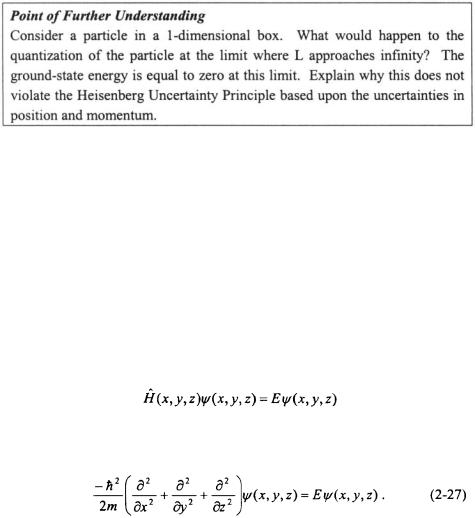
Fundamentals of Quantum Mechanics |
33 |
energy) would become undefined indicating that there would be no knowledge of the particle’s momentum. An understanding of why the ground-state energy for the Particle-in-a-Box is non-zero can now be rationalized. If the kinetic energy, and as a result the momentum, of the particle were zero, the position of the particle would also be precisely known because it is not in motion. This would be in direct violation of the Heisenberg Uncertainty Principle.
2.8PARTICLE IN A THREE-DIMENSIONAL BOX AND DEGENERACY
Particles normally are capable of travelling in three-dimensions, and the particle in a one-dimensional box can be readily expanded into three. The length of the box in each direction will be taken as  and
and  in the x, y, and z coordinates respectively. The potential within the box is zero and it is infinite at the walls: 0,
in the x, y, and z coordinates respectively. The potential within the box is zero and it is infinite at the walls: 0,  and
and  The Hamiltonian for the particle will correspond to kinetic energy in the x, y, and z coordinates. The Schroedinger equation for the particle is as follows:
The Hamiltonian for the particle will correspond to kinetic energy in the x, y, and z coordinates. The Schroedinger equation for the particle is as follows:
or
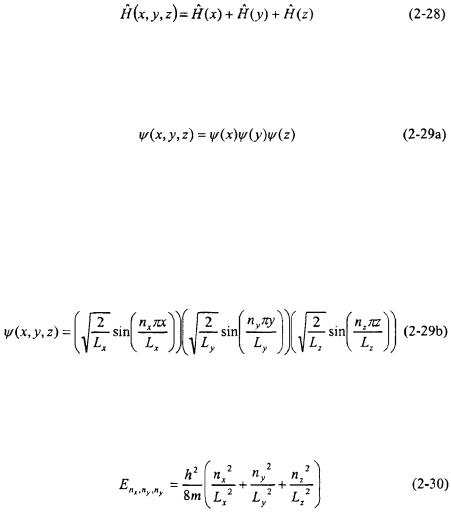
34 |
Chapter 2 |
The motion of the particle is independent in each dimension making this problem separable. Because the problem is separable, the Hamiltonian can be written as a sum of the Hamiltonians for each dimension.
In order to satisfy the Schroedinger equation (Equation 2-27), the wavefunction  must be the product of wavefunctions in each coordinate.
must be the product of wavefunctions in each coordinate.
In all separable systems, the Hamiltonian is represented as a sum along each independent variable, and the wavefunction for the system will be a product of the wavefunctions for each independent variable.
The system in each dimension is identical to a Particle-in-a-one- dimensional-Box. As a result, Equation 2-29a is a product of wavefunctions for the one-dimensional Particle-in-a-Box.
The energy eigenvalues are found by applying Equation 2-29b to the Hamiltonian in Equation 2-27. The energy eigenvalues will depend on three different quantum numbers:  and
and  corresponding to each coordinate.
corresponding to each coordinate.
where: 
Degeneracy occurs when there is more than one possible state with the same energy. Consider a particle in a three-dimensional box where the lengths in the x and y direction are equal:  Under these circumstances, it is possible to have, more than one state
Under these circumstances, it is possible to have, more than one state  with the
with the
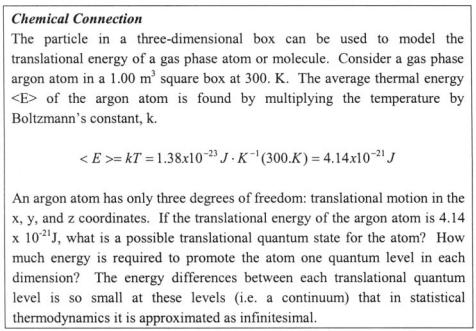
Fundamentals of Quantum Mechanics |
35 |
same energy. As an example, the state 1, 3, 2 will have the same energy as 3, 1, 2. Degeneracy is an important concept as it occurs often in chemical systems.
PROBLEMS AND EXERCISES
2.1) Calculate the de Broglie wavelength for a supersonic jet aircraft with mass of  travelling at
travelling at  Is this wavelength significant relative to the size of a typical fighter aircraft? Now calculate the de Broglie wavelength for an electron (mass equal to
Is this wavelength significant relative to the size of a typical fighter aircraft? Now calculate the de Broglie wavelength for an electron (mass equal to  ) with 13.7
) with 13.7  of kinetic energy. (The electron volt, eV, is a convenient unit for describing the energy of small particle such as an electron:
of kinetic energy. (The electron volt, eV, is a convenient unit for describing the energy of small particle such as an electron:  )
)
